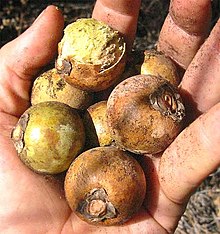Acrocomia aculeata
| Acrocomia aculeata | |
|---|---|

| |
| Scientific classification | |
| Kingdom: | Plantae |
| Clade: | Tracheophytes |
| Clade: | Angiosperms |
| Clade: | Monocots |
| Clade: | Commelinids |
| Order: | Arecales |
| Family: | Arecaceae |
| Genus: | Acrocomia |
| Species: | A. aculeata
|
| Binomial name | |
| Acrocomia aculeata | |
Acrocomia aculeata is a species of
Common names
Common names include grugru palm, gloo gloo, corojo, macaúba palm, coyol palm, and macaw palm; synonyms include A. lasiospatha, A. sclerocarpa, and A. vinifera.
Description


It grows up to 15–20 m tall, with a trunk up to 50 cm in diameter, characterized by numerous slender, black, viciously sharp 10 cm long spines jutting out from the trunk. The
Distribution and Habitat
The species is found from southern
, thriving in environments ranging from grasslands to subtropical forests.Ecology
The tree was noted by the English naturalist Henry Walter Bates in his 1863 book The Naturalist on the River Amazons, where he wrote that
[The hyacinth macaw] flies in pairs, and feeds on the hard nuts of several palms, but especially of the Mucuja (Acrocomia lasiospatha). These nuts, which are so hard as to be difficult to break with a heavy hammer, are crushed to a pulp by the powerful beak of this macaw.
— Bates[4]
Uses

The plants inhabit a wide variety of climates and situations; in
References
- Germplasm Resources Information Network: Acrocomia
- PACSOA: Acrocomia aculeata
- Project for Neotropical Fruits: Acrocomia aculeata
- Leuphana Universität, Lüneburg (2013) Macauba - Sustainable Palm Oil

